Estimation of Actual Evapotranspiration and Crop Coefficient of Transplanted Puddled Rice Using a Modified Non-Weighing Paddy Lysimeter
Abstract
:1. Introduction
2. Materials and Methods
2.1. Site Description, Climate, and Soil
2.2. Estimation of Actual Crop Evapotranspiration Using Paddy Lysimeter
2.3. Estimation of Reference Evapotranspiration
2.3.1. FAO Penman–Monteith Equation
2.3.2. Pan Evaporation Approach
2.4. Estimation of Stagewise Crop Coefficient
2.5. Statistical Analysis
2.6. Water Productivity and Agro-Meteorological Indices
3. Results
3.1. Variation in Reference Evapotranspiration, Water Balance Components and Actual Crop Evapotranspiration
3.2. Comparation of Actual Evapotranspiration with FAO-PMand Pan Evaporation-Derived Evapotranpiration during Crop Period
3.3. Comparison of Stagewise Actual Kc vs. Single FAO-56 Kc Values and Derived Pan–Crop Coefficient Values
3.4. Influence of Weather Variables on Reference and Actual Evapotranspiration
3.5. Water Productivity and Agro-Meteorological Indices
4. Discussion
4.1. Variation in Reference Evapotranspiration, Water Balance Components, and Actual Evapotranspiration
4.2. Comparison of Crop Evapotranspiration and Stagewise Crop Coefficients
4.3. Influence of Weather Variables on Reference and Actual Evapotranspiration
4.4. Assessment of Water Productivity (WP) and Agro-Meteorological Indices
5. Conclusions
Author Contributions
Funding
Data Availability Statement
Acknowledgments
Conflicts of Interest
References
- Boretti, A.; Rosa, L. Reassessing the Projections of the World Water Development Report. NPJ Clean Water 2019, 2, 15. [Google Scholar] [CrossRef] [Green Version]
- Dimple, D.; Rajput, J.; Al-Ansari, N.; Elbeltagi, A.; Zerouali, B.; Santos, C.A.G. Determining the Hydrological Behaviour of Catchment Based on Quantitative Morphometric Analysis in the Hard Rock Area of Nand Samand Catchment, Rajasthan, India. Hydrology 2022, 9, 31. [Google Scholar] [CrossRef]
- Rajput, J.; Kothari, M.; Bhakar, S.R.; Dimple; Kushwaha, N.L.; Singh, P.K.; Paramaguru, P.K.; Rai, A.; Elbeltagi, A.; Rana, L. Evaluation of Water Delivery Performance of Right Main Canal of Bhimsagar Medium Irrigation Scheme, Rajasthan. ISH J. Hydraul. Eng. 2022, 1–11. [Google Scholar] [CrossRef]
- Rajput, J.; Kothari, M.; Kumari, A. Development of Optimum Irrigation Schedule and Rotational Water Allocation Plan for Bhimsagar Canal Command System. Int. J. Agric. Sci. 2018, 10, 5849–5853. [Google Scholar]
- World Water Development Report. 2018. Available online: https://www.unwater.org/publications/world-water-development-report-2018 (accessed on 24 September 2022).
- Rajput, J.; Kothari, M.; Bhakar, S.R. Performance Evaluation of Water Delivery System for Command Area of Left Main Canal of Bhimsagar Irrigation Project, Rajasthan. J. Agric. Eng. 2017, 54, 57–66. [Google Scholar]
- Choudhury, B.U.; Singh, A.K.; Pradhan, S. Estimation of Crop Coefficients of Dry-Seeded Irrigated Rice–Wheat Rotation on Raised Beds by Field Water Balance Method in the Indo-Gangetic Plains, India. Agric. Water Manag. 2013, 123, 20–31. [Google Scholar] [CrossRef]
- Sekar, I.; Pal, S. Rice and Wheat Crop Productivity in the Indo-Gangetic Plains of India: Changing Pattern of Growth and Future Strategies. Indian J. Agric. Econ. 2012, 67, 1–15. [Google Scholar]
- Bouman, B. How Much Water Does Rice Use? Rice Today 2009, 8, 28–29. [Google Scholar]
- Geethalakshmi, V.; Ramesh, T.; Palamuthirsolai, A. Lakshmanan Agronomic Evaluation of Rice Cultivation Systems for Water and Grain Productivity. Arch. Agron. Soil Sci. 2011, 57, 159–166. [Google Scholar] [CrossRef]
- Kumar, N.; Chhokar, R.S.; Meena, R.P.; Kharub, A.S.; Gill, S.C.; Tripathi, S.C.; Gupta, O.P.; Mangrauthia, S.K.; Sundaram, R.M.; Sawant, C.P.; et al. Challenges and Opportunities in Productivity and Sustainability of Rice Cultivation System: A Critical Review in Indian Perspective. Cereal Res. Commun. 2021, 1–29. [Google Scholar] [CrossRef]
- Tuong, T.P.; Bouman, B.A.M. Rice Production in Water-Scarce Environments; International Water Management Institute: Colombo, Sri Lanka, 2003. [Google Scholar]
- Bhatt, R.; Kukal, S.S.; Busari, M.A.; Arora, S.; Yadav, M. Sustainability Issues on Rice–Wheat Cropping System. Int. Soil Water Conserv. Res. 2016, 4, 64–74. [Google Scholar] [CrossRef] [Green Version]
- Yadav, S.; Humphreys, E.; Kukal, S.; Gill, G.; Ramaswamy, R. Effect of Water Management on Dry Seeded and Puddled Transplanted Rice: Part 2: Water Balance and Water Productivity. Field Crops Res. 2011, 120, 123–132. [Google Scholar] [CrossRef]
- Bouman, B.; Tuong, T.P. Field Water Management to Save Water and Increase in Productivity in Irrigated Lowland Rice. Agric. Water Manag. 2001, 49, 11–30. [Google Scholar] [CrossRef]
- Choudhury, B.; Bouman, B.; Singh, A.K. Yield and Water Productivity of Rice–Wheat on Raised Beds at New Delhi, India. Field Crops Res. 2007, 100, 229–239. [Google Scholar] [CrossRef]
- Angaleeswari, M.; Ravikumar, V.; Kannan, S.V. Evapotranspiration Estimation by Inverse Soil Water Flow Modelling. Irrig. Sci. 2021, 39, 633–649. [Google Scholar] [CrossRef]
- Tyagi, N.; Sharma, D.; Luthra, S. Determination of Evapotranspiration and Crop Coefficients of Rice and Sunflower with Lysimeter. Agric. Water Manag. 2000, 45, 41–54. [Google Scholar] [CrossRef]
- Tyagi, N.; Sharma, D.; Luthra, S. Evapotranspiration and Crop Coefficients of Wheat and Sorghum. J. Irrig. Drain. Eng. Asce 2000, 126, 215–222. [Google Scholar] [CrossRef]
- Allen, R.; Pereira, L.; Raes, D.; Smith, M. FAO Irrigation and Drainage Paper No. 56. Rome Food Agric. Organ. United Nations 1998, 56, 26–40. [Google Scholar]
- Gaddikeri, V.; Hasan, M.; Kumar, D.; Sarangi, A.; Alam, W. Performance Analysis and Measurement of Soil Moisture Content by Piezoresistive Sensor. Mapan 2022, 37, 149–160. [Google Scholar] [CrossRef]
- Popova, Z.; Pereira, L.S. Modelling for maize irrigation scheduling using long term experimental data from Plovdiv region, Bulgaria. Agric. Water Manag. 2011, 98, 675–683. [Google Scholar] [CrossRef]
- Rodrigues, G.C.; Pereira, L.S. Assessing Economic Impacts of Deficit Irrigation as Related to Water Productivity and Water Costs. Biosyst. Eng. 2009, 103, 536–551. [Google Scholar] [CrossRef] [Green Version]
- Allen, R.G.; Pruitt, W.O.; Wright, J.L.; Howell, T.A.; Ventura, F.; Snyder, R.; Itenfisu, D.; Steduto, P.; Berengena, J.; Yrisarry, J.B.; et al. A Recommendation on Standardized Surface Resistance for Hourly Calculation of Reference ETo by the FAO56 Penman-Monteith Method. Agric. Water Manag. 2006, 81, 1–22. [Google Scholar] [CrossRef]
- Beeson , R.C., Jr. Weighing Lysimeter Systems for Quantifying Water Use and Studies of Controlled Water Stress for Crops Grown in Low Bulk Density Substrates. Agric. Water Manag. 2011, 98, 967–976. [Google Scholar] [CrossRef]
- Cai, X.; Mckinney, D.; Lasdon, L. Integrated Hydrologic-Agronomic-Economic Model for River Basin Management. J. Water Resour. Plan. Manag. Asce 2003, 129, 4–17. [Google Scholar] [CrossRef] [Green Version]
- Satti, S.R.; Jacobs, J.M.; Irmak, S. Agricultural Water Management in a Humid Region: Sensitivity to Climate, Soil and Crop Parameters. Agric. Water Manag. 2004, 70, 51–65. [Google Scholar] [CrossRef]
- Babaee, M.; Shokat-Naghadeh, A.; Ahmadpari, H.; Nabi-Jalali, M. Comparison of Different Methods with Lysimeter Measurements in Estimation of Rice Evapotranspiration in Sari Region. Rev. Ing. UC 2019, 26, 175–184. [Google Scholar]
- Djaman, K.; Rudnick, D.R.; Moukoumbi, Y.D.; Sow, A.; Irmak, S. Actual Evapotranspiration and Crop Coefficients of Irrigated Lowland Rice (Oryza sativa L.) under Semiarid Climate. Ital. J. Agron. 2019, 14, 19–25. [Google Scholar] [CrossRef] [Green Version]
- Chatterjee, S.; Stoy, P.; Debnath, M.; Nayak, A.K.; Swain, C.; Tripathi, R.; Chatterjee, D.; Mahapatra, S.; Talib, A. Actual Evapotranspiration and Crop Coefficients for Tropical Lowland Rice (Oryza sativa L.) in Eastern India. Theor. Appl. Climatol. 2021, 146, 155–171. [Google Scholar] [CrossRef]
- Choudhury, B.U.; Singh, A.K. Estimation of Crop Coefficient of Irrigated Transplanted Puddled Rice by Field Scale Water Balance in the Semi-Arid Indo-Gangetic Plains, India. Agric. Water Manag. 2016, 176, 142–150. [Google Scholar] [CrossRef]
- Alberto, M.C.R.; Quilty, J.R.; Buresh, R.J.; Wassmann, R.; Haidar, S.; Correa, T.Q.; Sandro, J.M. Actual Evapotranspiration and Dual Crop Coefficients for Dry-Seeded Rice and Hybrid Maize Grown with Overhead Sprinkler Irrigation. Agric. Water 2014, 136, 1–12. [Google Scholar] [CrossRef]
- Timm, A.U.; Roberti, D.R.; Streck, N.A.; de Gonçalves, L.G.G.; Acevedo, O.C.; Moraes, O.L.L.; Moreira, V.S.; Degrazia, G.A.; Ferlan, M.; Toll, D.L. Energy Partitioning and Evapotranspiration over a Rice Paddy in Southern Brazil. J. Hydrometeorol. 2014, 15, 1975–1988. [Google Scholar] [CrossRef]
- Arif, C.; Setiawan, B.I.; Sofiyuddin, H.A.; Martief, L.M.; Mizoguchi, M.; Doi, R. Estimating Crop Coefficient in Intermittent Irrigation Paddy Fields Using Excel Solver. Rice Sci. 2012, 19, 143–152. [Google Scholar] [CrossRef] [Green Version]
- Arif, C.; Setiawan, B.I.; Mizoguchi, M.; Doi, R. Estimation of Water Balance Components in Paddy Fields under Non-Flooded Irrigation Regimes by Using Excel Solver. J. Agron. 2012, 11, 53–59. [Google Scholar] [CrossRef] [Green Version]
- Garcia, M.; Raes, D.; Jacobsen, S.-E. Evapotranspiration Analysis and Irrigation Requirements of Quinoa (Chenopodium Quinoa) in the Bolivian Highlands. Agric. Water Manag. 2003, 60, 119–134. [Google Scholar] [CrossRef]
- Pulvento, C.; Riccardi, M.; Lavini, A.; D’Andria, R.; Ragab, R. Parameterization and Field Validation of Saltmed Model for Grain Amaranth Tested in South Italy. Irrig. Drain. 2015, 64, 59–68. [Google Scholar] [CrossRef]
- French, A.N.; Hunsaker, D.J.; Sanchez, C.A.; Saber, M.; Gonzalez, J.R.; Anderson, R. Satellite-Based NDVI Crop Coefficients and Evapotranspiration with Eddy Covariance Validation for Multiple Durum Wheat Fields in the US Southwest. Agric. Water Manag. 2020, 239, 106266. [Google Scholar] [CrossRef]
- Zhang, B.; Liu, Y.; Xu, D.; Zhao, N.; Lei, B.; Rosa, R.D.; Paredes, P.; Paço, T.A.; Pereira, L.S. The Dual Crop Coefficient Approach to Estimate and Partitioning Evapotranspiration of the Winter Wheat–Summer Maize Crop Sequence in North China Plain. Irrig. Sci. 2013, 31, 1303–1316. [Google Scholar] [CrossRef]
- Tripathi, R.P. Evapotranspiration and Crop Coefficient for Rice, Wheat and Pulses under Shallow Water Table Conditions of Tarai Region of Uttaranchal. J. Agrometeorol. 2004, 6, 17–29. [Google Scholar] [CrossRef]
- Mohan, S.; Arumugam, N. Irrigation Crop Coefficients for Lowland Rice. Irrig. Drain. Syst. 1994, 8, 159–176. [Google Scholar] [CrossRef]
- Kingra, P.; Hundal, S.; Sharma, P. Characterization of Crop Coefficients for Wheat and Rice Crops in Punjab. J. Agrometeorol. 2004, 6, 58–60. [Google Scholar]
- Moratiel, R.; Martínez-Cob, A. Evapotranspiration and Crop Coefficients of Rice (Oryza sativa L.) under Sprinkler Irrigation in a Semiarid Climate Determined by the Surface Renewal Method. Irrig. Sci. 2013, 31, 411–422. [Google Scholar] [CrossRef] [Green Version]
- Laike, S.; Tilahun, K.; Hordofa, T. Crop Coefficient of Haricot Bean at Melkassa, Central Rift Valley of Ethiopia. JARTS 2006, 107, 33–40. [Google Scholar]
- Patil, A.; Tiwari, K.N. Yield Assessment, N Uptake and KC Development of Green Gram Crop during Wet Season of India. Arch. Agron. Soil Sci. 2021, 67, 313–328. [Google Scholar] [CrossRef]
- López-Urrea, R.; Montoro, A.; González-Piqueras, J.; López-Fuster, P.; Fereres, E. Water Use of Spring Wheat to Raise Water Productivity. Agric. Water Manag. 2009, 96, 1305–1310. [Google Scholar] [CrossRef]
- López-Urrea, R.; Sánchez, J.M.; de la Cruz, F.; González-Piqueras, J.; Chávez, J.L. Evapotranspiration and Crop Coefficients from Lysimeter Measurements for Sprinkler-Irrigated Canola. Agric. Water Manag. 2020, 239, 1–10. [Google Scholar] [CrossRef]
- Cavalcante Junior, E.G.; de Medeiros, J.F.; Espínola Sobrinho, J.; Figueirêdo, V.B.; da Costa, J.P.N.; de O. Santos, W. Development and Water Requirements of Cowpea under Climate Change Conditions in the Brazilian Semi-Arid Region. Rev. Bras. Eng. Agríc. Ambient. 2016, 20, 783–788. [Google Scholar] [CrossRef]
- Hatiye, S.D.; Hari Prasad, K.S.; Ojha, C.S.P.; Adeloye, A.J. Estimation and Characterization of Deep Percolation from Rice and Berseem Fields Using Lysimeter Experiments on Sandy Loam Soil. J. Hydrol. Eng. 2016, 21, 05016006. [Google Scholar] [CrossRef]
- Kar, G.; Kumar, A.; Martha, M. Water Use Efficiency and Crop Coefficients of Dry Season Oilseed Crops. Agric. Water Manag. 2007, 87, 73–82. [Google Scholar] [CrossRef]
- Chahal, G.B.S.; Sood, A.; Jalota, S.K.; Choudhury, B.U.; Sharma, P.K. Yield, Evapotranspiration and Water Productivity of Rice (Oryza sativa L.)-Wheat (Triticum aestivum L.) System in Punjab (India) as Influenced by Transplanting Date of Rice and Weather Parameters. Agric. Water Manag. 2007, 88, 14–22. [Google Scholar] [CrossRef]
- Sivapalan, S. Water Balance of Flooded Rice in the Tropics. In Irrigation and Drainage; Javaid, M.S., Ed.; IntechOpen: Rijeka, Croatia, 2015. [Google Scholar]
- Shiraki, S.; Cho, T.M.; Matsuno, Y.; Shinogi, Y. Evapotranspiration and Crop Coefficient of Ratoon Rice Crop Determined by Water Depth Observation and Bayesian Inference. Agronomy 2021, 11, 1573. [Google Scholar] [CrossRef]
- Doorenbos, J.; Pruitt, W.O. Guidelines for Predicting Crop Water Requirements. Irrig. Drain. Pap. FAO 1975, 24, 1–179. [Google Scholar]
- Bouyoucos, G.J. Hydrometer Method Improved for Making Particle Size Analyses of Soils1. Agron. J. 1962, 54, 464–465. [Google Scholar] [CrossRef]
- Klute, A.; Dirksen, C. Hydraulic Conductivity and Diffusivity: Laboratory Methods. In Methods of Soil Analysis; John Wiley & Sons, Ltd.: Hoboken, NJ, USA, 1986; pp. 687–734. ISBN 978-0-89118-864-3. [Google Scholar]
- Blake, G.R.; Hartge, K.H. Bulk Density. In Methods of Soil Analysis; John Wiley & Sons, Ltd.: Hoboken, NJ, USA, 1986; pp. 363–375. ISBN 978-0-89118-864-3. [Google Scholar]
- Wirth, E.H. Soil and Plant Analysis, by C. S. PIPER. Interscience Publishers, Inc., New York. J. Am. Pharm. Assoc. 1946, 35, 192. [Google Scholar] [CrossRef]
- Walkley, A.; Black, I.A. An Examination Of The Degtjareff Method for Determining Soil Organic Matter, and A Proposed Modification of the Chromic Acid Titration Method. Soil Sci. 1934, 37, 29–38. [Google Scholar] [CrossRef]
- Cassel, D.K.; Nielsen, D.R. Field Capacity and Available Water Capacity. In Methods of Soil Analysis; John Wiley & Sons, Ltd.: Hoboken, NJ, USA, 1986; pp. 901–926. ISBN 978-0-89118-864-3. [Google Scholar]
- Passioura, J. Increasing Crop Productivity When Water Is Scarce—From Breeding to Field Management. Agric. Water Manag. 2006, 80, 176–196. [Google Scholar] [CrossRef] [Green Version]
- Ali, M.H.; Talukder, M.S.U. Increasing Water Productivity in Crop Production—A Synthesis. Agric. Water Manag. 2008, 95, 1201–1213. [Google Scholar] [CrossRef]
- Hobbins, M.T.; Ramírez, J.A.; Brown, T.C. Trends in Pan Evaporation and Actual Evapotranspiration across the Conterminous U.S.: Paradoxical or Complementary? Geophys. Res. Lett. 2004, 31, 2665–2668. [Google Scholar] [CrossRef] [Green Version]
- van Heerwaarden, C.C.; Vilà-Guerau de Arellano, J.; Teuling, A.J. Land-Atmosphere Coupling Explains the Link between Pan Evaporation and Actual Evapotranspiration Trends in a Changing Climate. Geophys. Res. Lett. 2010, 37, 1–15. [Google Scholar] [CrossRef] [Green Version]
- Zhang, Y.; Liu, C.; Tang, Y.; Yang, Y. Trends in Pan Evaporation and Reference and Actual Evapotranspiration across the Tibetan Plateau. J. Geophys. Res. Atmos. 2007, 112, 1–12. [Google Scholar] [CrossRef]
- Rowshon, M.K.; Amin, M.S.M.; Mojid, M.A.; Yaji, M. Estimated Evapotranspiration of Rice Based on Pan Evaporation as a Surrogate to Lysimeter Measurement. Paddy Water Environ. 2014, 12, 35–41. [Google Scholar] [CrossRef]
- Lawrimore, J.H.; Peterson, T.C. Pan Evaporation Trends in Dry and Humid Regions of the United States. J. Hydrometeorol. 2000, 1, 543–546. [Google Scholar] [CrossRef]
- Golubev, V.S.; Lawrimore, J.H.; Groisman, P.Y.; Speranskaya, N.A.; Zhuravin, S.A.; Menne, M.J.; Peterson, T.C.; Malone, R.W. Evaporation Changes over the Contiguous United States and the Former USSR: A Reassessment. Geophys. Res. Lett. 2001, 28, 2665–2668. [Google Scholar] [CrossRef]
- Kahler, D.M.; Brutsaert, W. Complementary Relationship between Daily Evaporation in the Environment and Pan Evaporation. Water Resour. Res. 2006, 42, 1–9. [Google Scholar] [CrossRef]
- Jyotiprava Dash, C.; Sarangi, A.; Singh, D.K.; Singh, A.K.; Adhikary, P.P. Prediction of Root Zone Water and Nitrogen Balance in an Irrigated Rice Field Using a Simulation Model. Paddy Water Environ. 2015, 13, 281–290. [Google Scholar] [CrossRef]
- Tuong, T.P. Productive Water Use in Rice Production. J. Crop Prod. 2000, 2, 241–264. [Google Scholar] [CrossRef]
- Alberto, M.C.R.; Wassmann, R.; Hirano, T.; Miyata, A.; Hatano, R.; Kumar, A.; Padre, A.; Amante, M. Comparisons of Energy Balance and Evapotranspiration between Flooded and Aerobic Rice Fields in the Philippines. Agric. Water Manag. 2011, 98, 1417–1430. [Google Scholar] [CrossRef]
- Maina, M.M.; Amin, M.S.M.; Aimrun, W.; Asha, T.S. Evaluation of Different ET [Evapotranspiration] Calculation Methods: A Case Study in Kano State, Nigeria. Philipp. Agric. Sci. 2012, 95, 394–399. [Google Scholar]
- Snyder, R.L.; Orang, M.; Matyac, S.; Grismer, M.E. Simplified Estimation of Reference Evapotranspiration from Pan Evaporation Data in California. J. Irrig. Drain. Eng. 2005, 131, 249–253. [Google Scholar] [CrossRef]
- Ghare, A.D.; Porey, P.D.; Ingle, R.N. Discussion of “Simplified Estimation of Reference Evapotranspiration from Pan Evaporation Data in California” by Richard L. Snyder, Morteza Orang, Scott Matyac, and Mark E. Grismer. J. Irrig. Drain. Eng. 2006, 132, 519–520. [Google Scholar] [CrossRef]
- Cobaner, M. Reference Evapotranspiration Based on Class A Pan Evaporation via Wavelet Regression Technique. Irrig. Sci. 2011, 31, 119–134. [Google Scholar] [CrossRef]
- Sabziparvar, A.-A.; Tabari, H.; Aeini, A.; Ghafouri, M. Evaluation of Class A Pan Coefficient Models for Estimation of Reference Crop Evapotranspiration in Cold Semi-Arid and Warm Arid Climates. Water Resour. Manag. Int. J. Publ. Eur. Water Resour. Assoc. 2010, 24, 909–920. [Google Scholar] [CrossRef]
- Conceição, M.A.F. Reference Evapotranspiration Based on Class A Pan Evaporation. Sci. Agric. 2002, 59, 417–420. [Google Scholar] [CrossRef]
- Midmore, D.J.; Cartwright, P.M.; Fischer, R.A. Wheat in Tropical Environments. II. Crop Growth and Grain Yield. Field Crops Res. 1984, 8, 207–227. [Google Scholar] [CrossRef]
- Kuo, S.-F.; Ho, S.-S.; Liu, C.W. Estimation Irrigation Water Requirements with Derived Crop Coefficients for Upland and Paddy Crops in ChiaNan Irrigation Association, Taiwan 2005. Agric. Water Manag. 2006, 82, 433–451. [Google Scholar] [CrossRef]
- Roderick, M.L.; Rotstayn, L.D.; Farquhar, G.D.; Hobbins, M.T. On the Attribution of Changing Pan Evaporation. Geophys. Res. Lett. 2007, 34, L17403. [Google Scholar] [CrossRef] [Green Version]
- Pereira, L.S.; Paredes, P.; Hunsaker, D.J.; López-Urrea, R.; Mohammadi Shad, Z. Standard Single and Basal Crop Coefficients for Field Crops. Updates and Advances to the FAO56 Crop Water Requirements Method. Agric. Water Manag. 2021, 243, 106466. [Google Scholar] [CrossRef]
- Pradhan, S.; Sehgal, V.; Bandyopadhyay, K.; Singh, R. Evapo-Transpiration Based Irrigation Scheduling. In Training Manual; Division of Agricultural Physics: New Delhi, India; Indian Agricultural Research Institute: New Delhi, India, 2012; pp. 80–86. [Google Scholar]
- Jagtap, D.N.; Sutar, M.W.; Mahadkar, U.V.; Chavan, S.A.; Pinjari, S.S.; Jadhav, M.S. Study of Agrometeorological Indices as Affected by Different Duration Rice Varieties and Crop Establishment Methods. IJBSM 2018, 9, 655–660. [Google Scholar] [CrossRef]
- López, R.; Jiménez-Chong, J.; Hernández-Aragón, L.; Ibarra, M. Water Productivity of Rice Genotypes with Irrigation and Drainage: Water Productivity of Rice. Irrig. Drain. 2018, 67, 508–515. [Google Scholar] [CrossRef]
- Mboyerwa, P.A.; Kibret, K.; Mtakwa, P.W.; Aschalew, A. Evaluation of Growth, Yield, and Water Productivity of Paddy Rice with Water-Saving Irrigation and Optimization of Nitrogen Fertilization. Agronomy 2021, 11, 1629. [Google Scholar] [CrossRef]
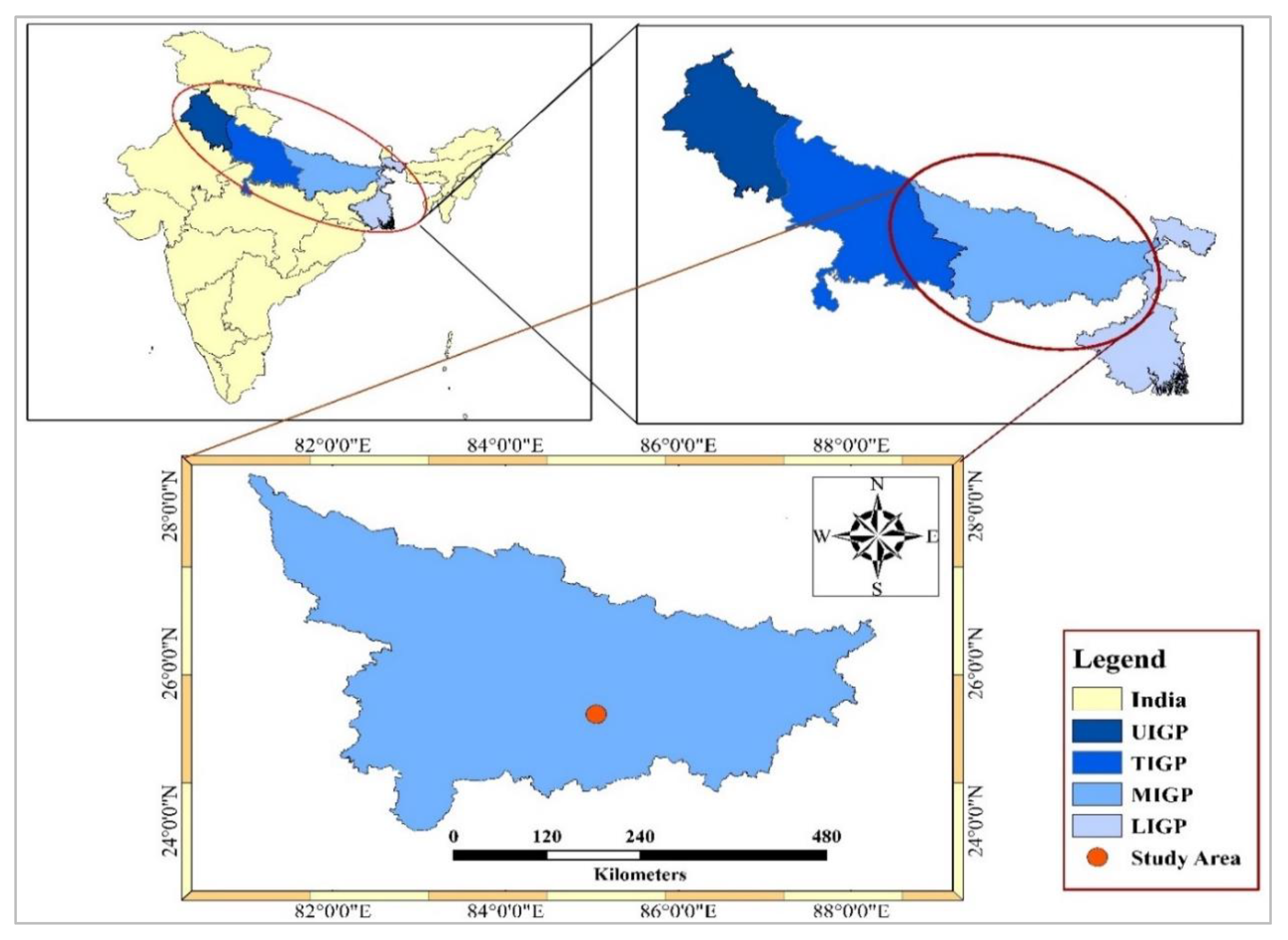
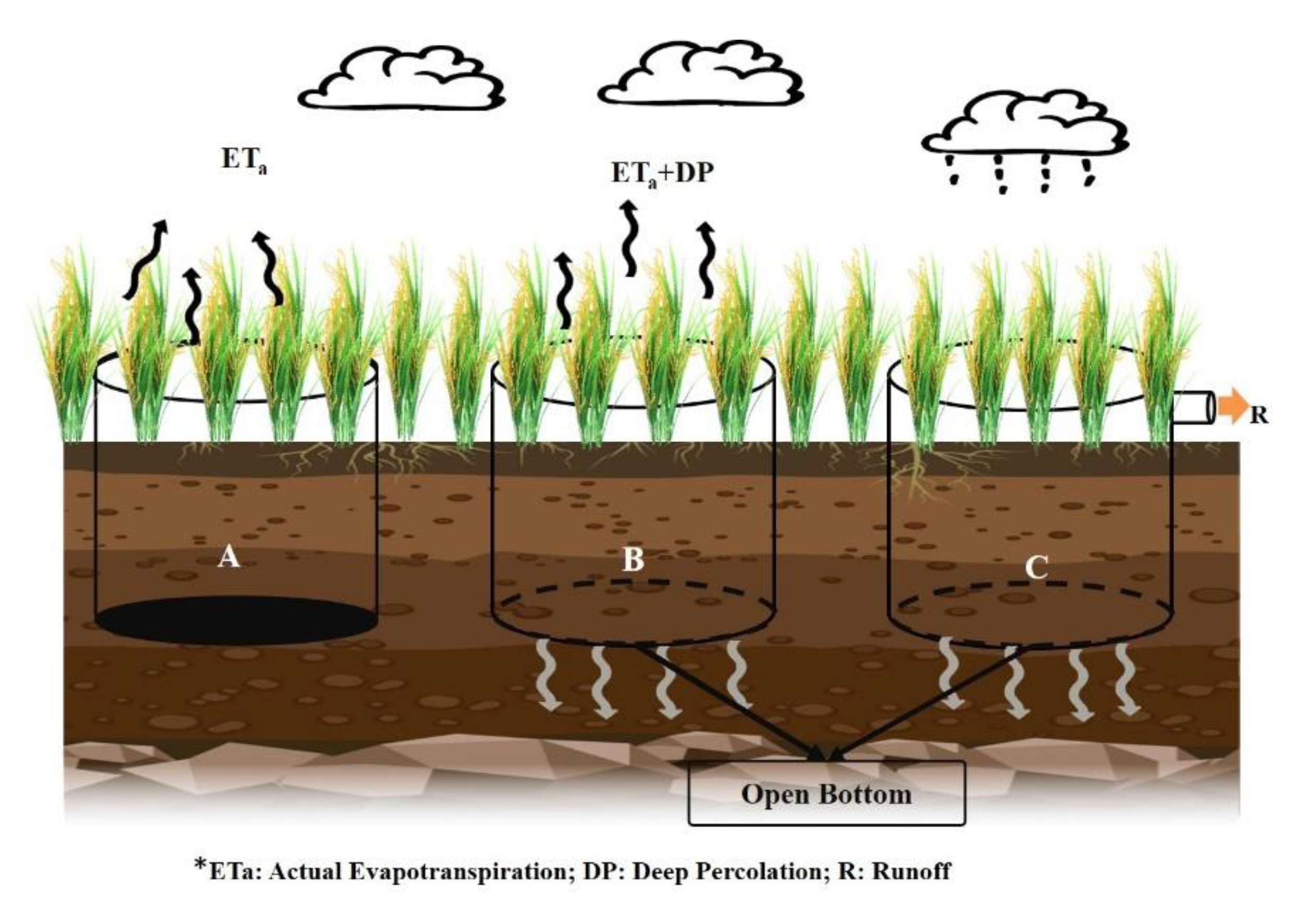

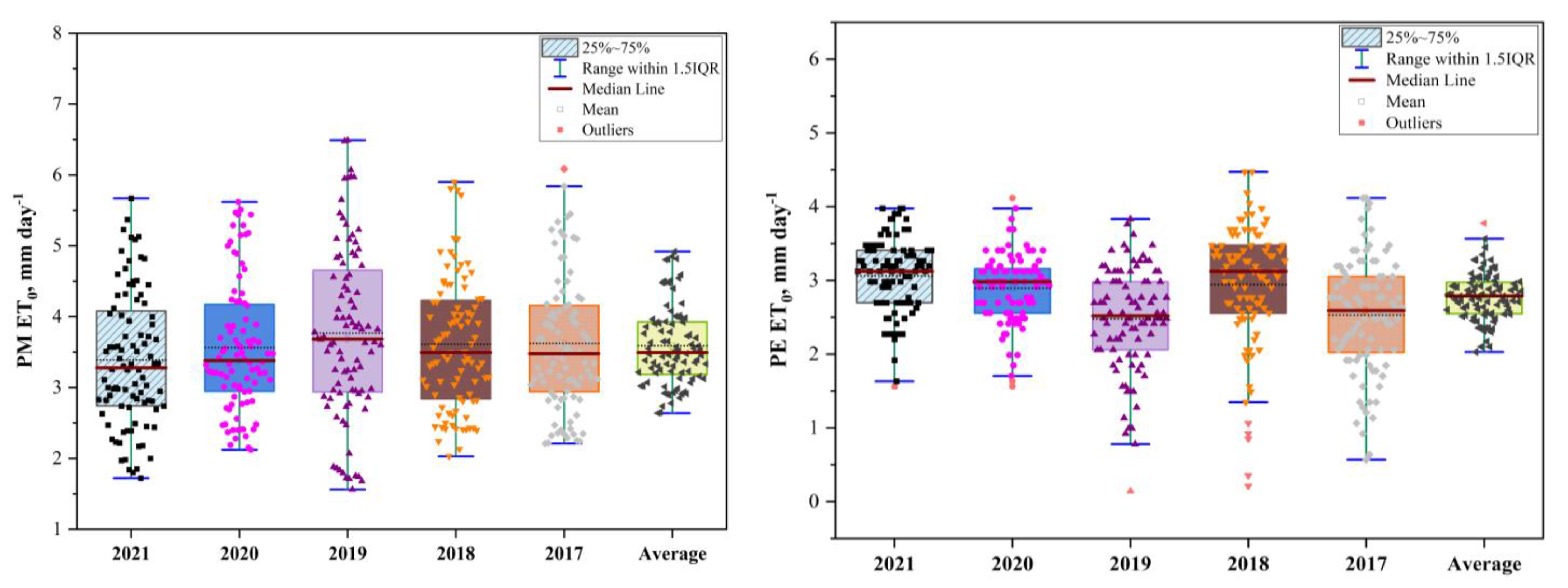


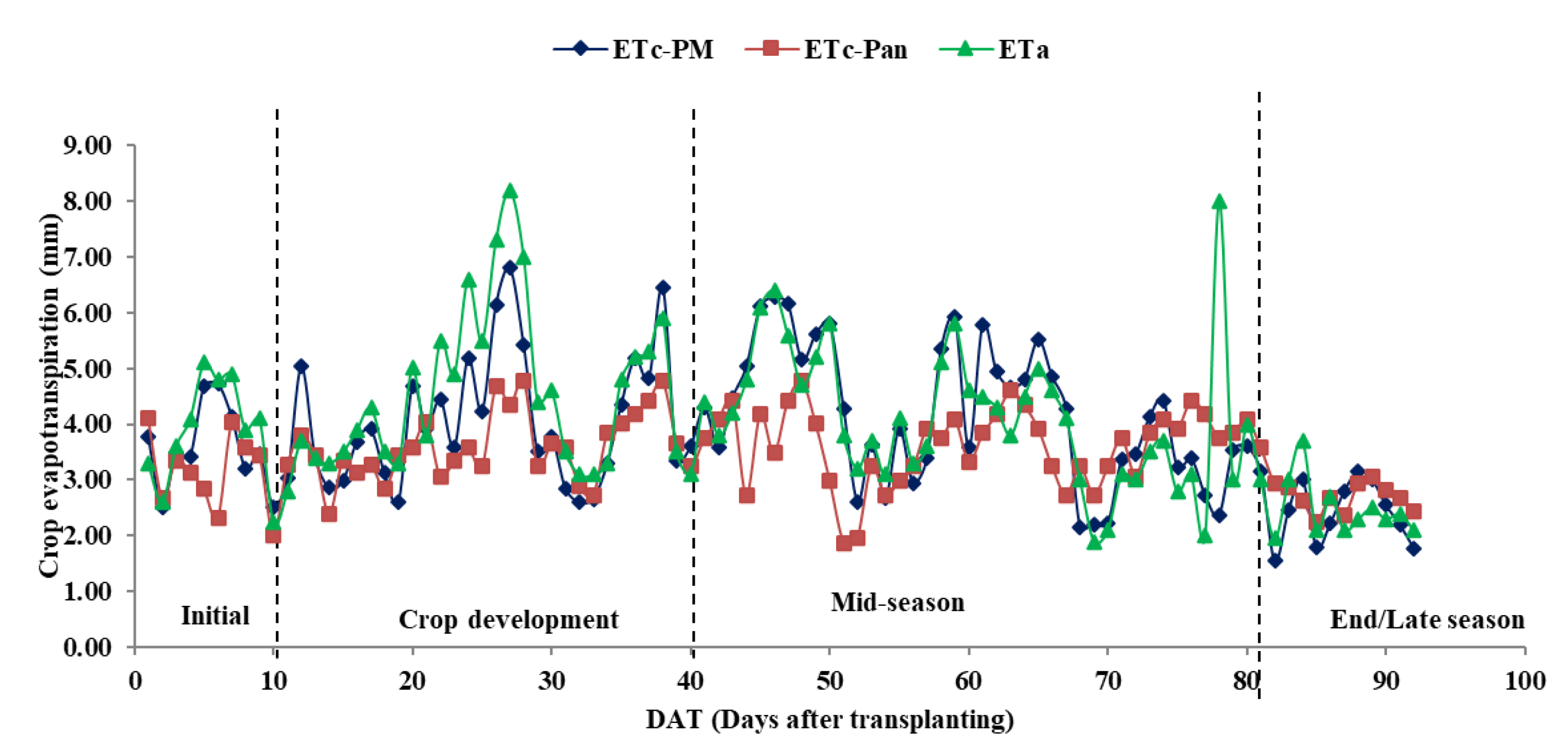
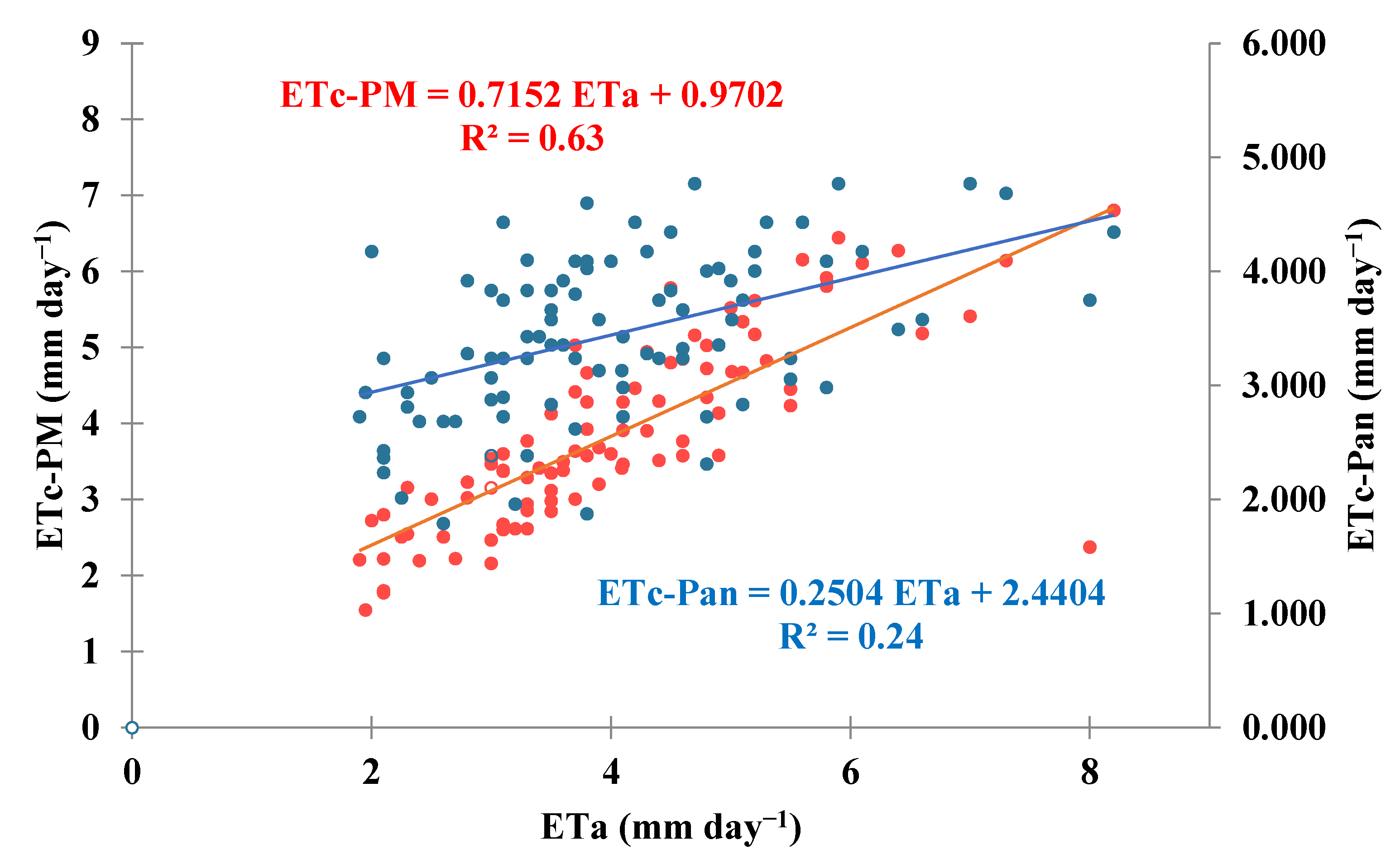


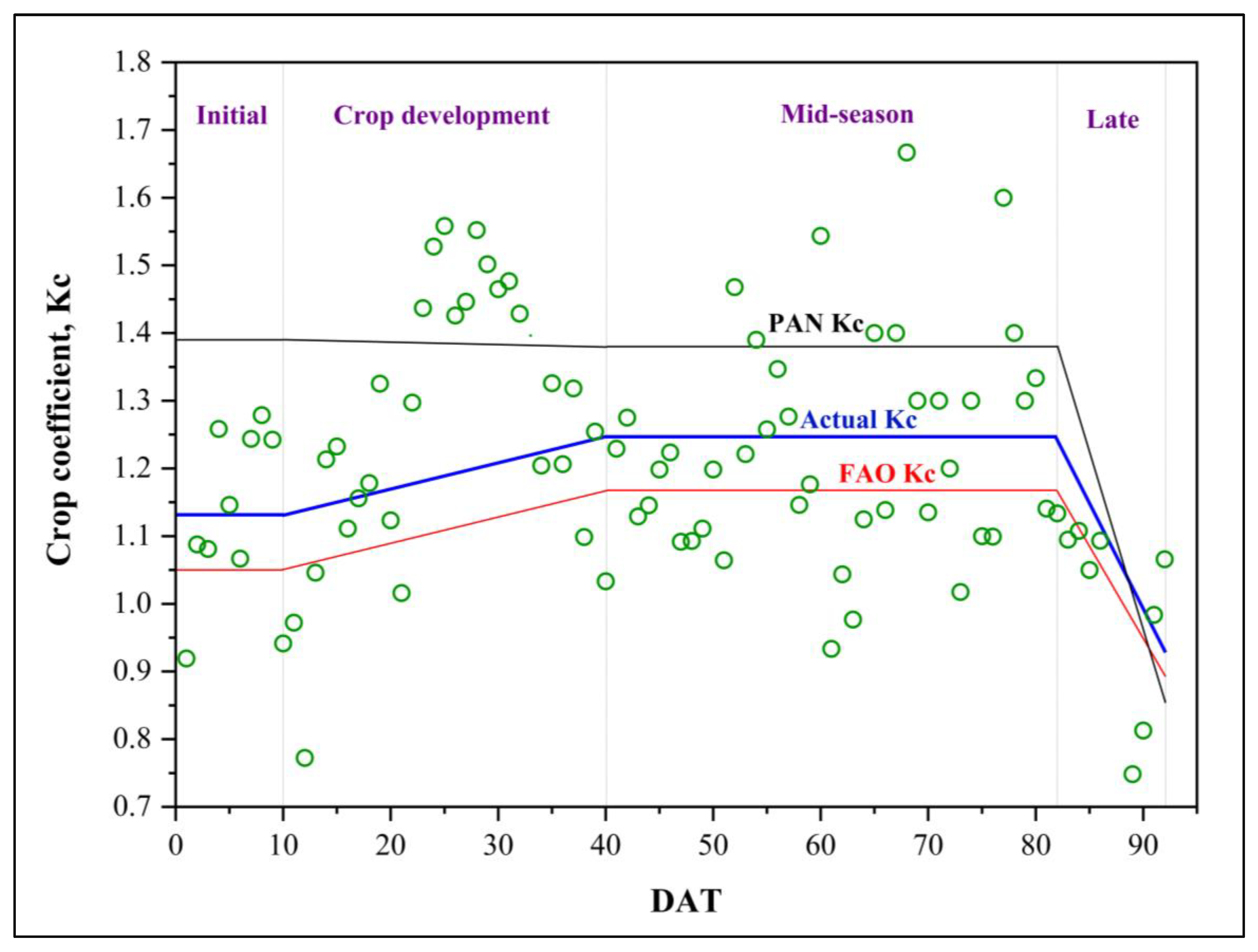
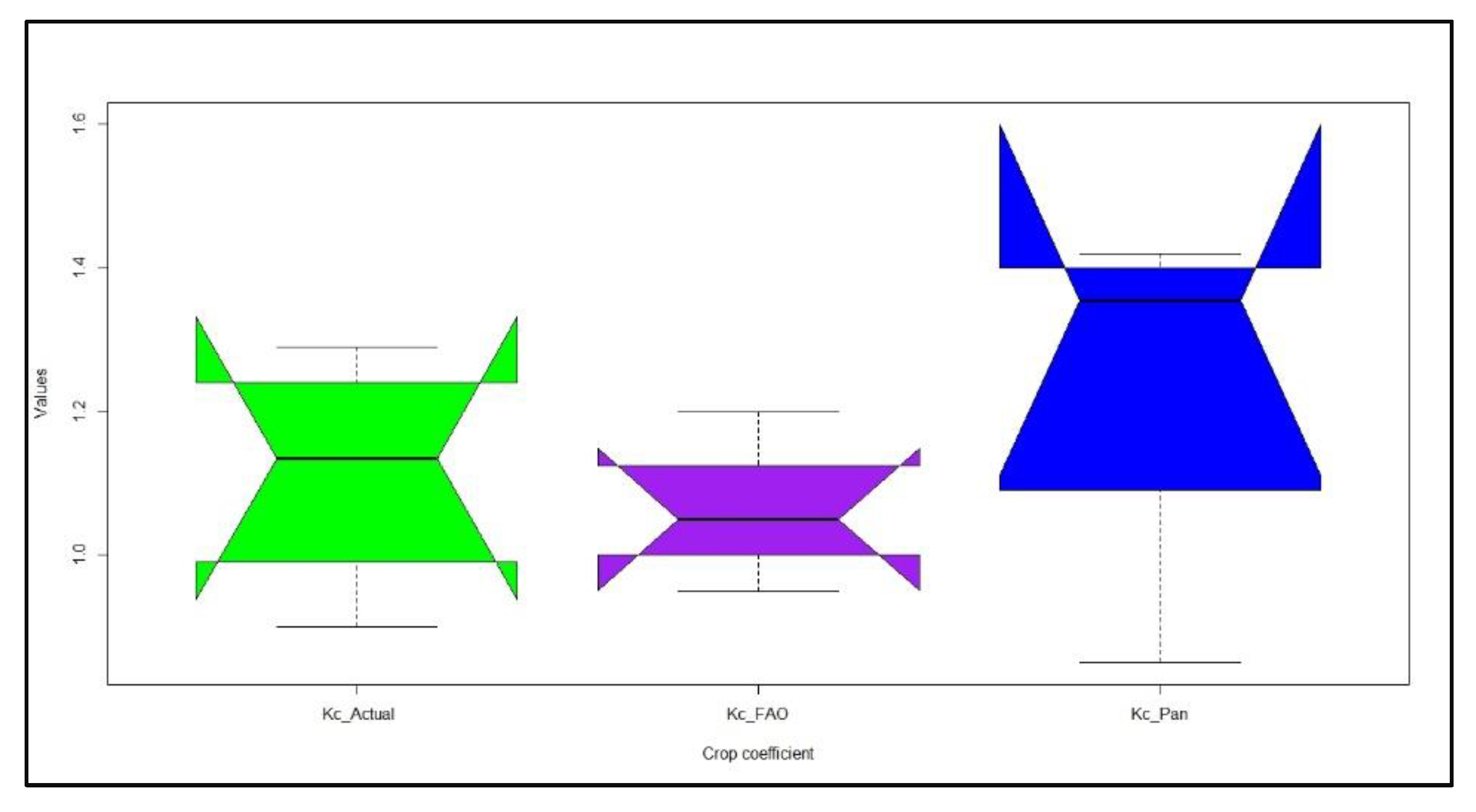
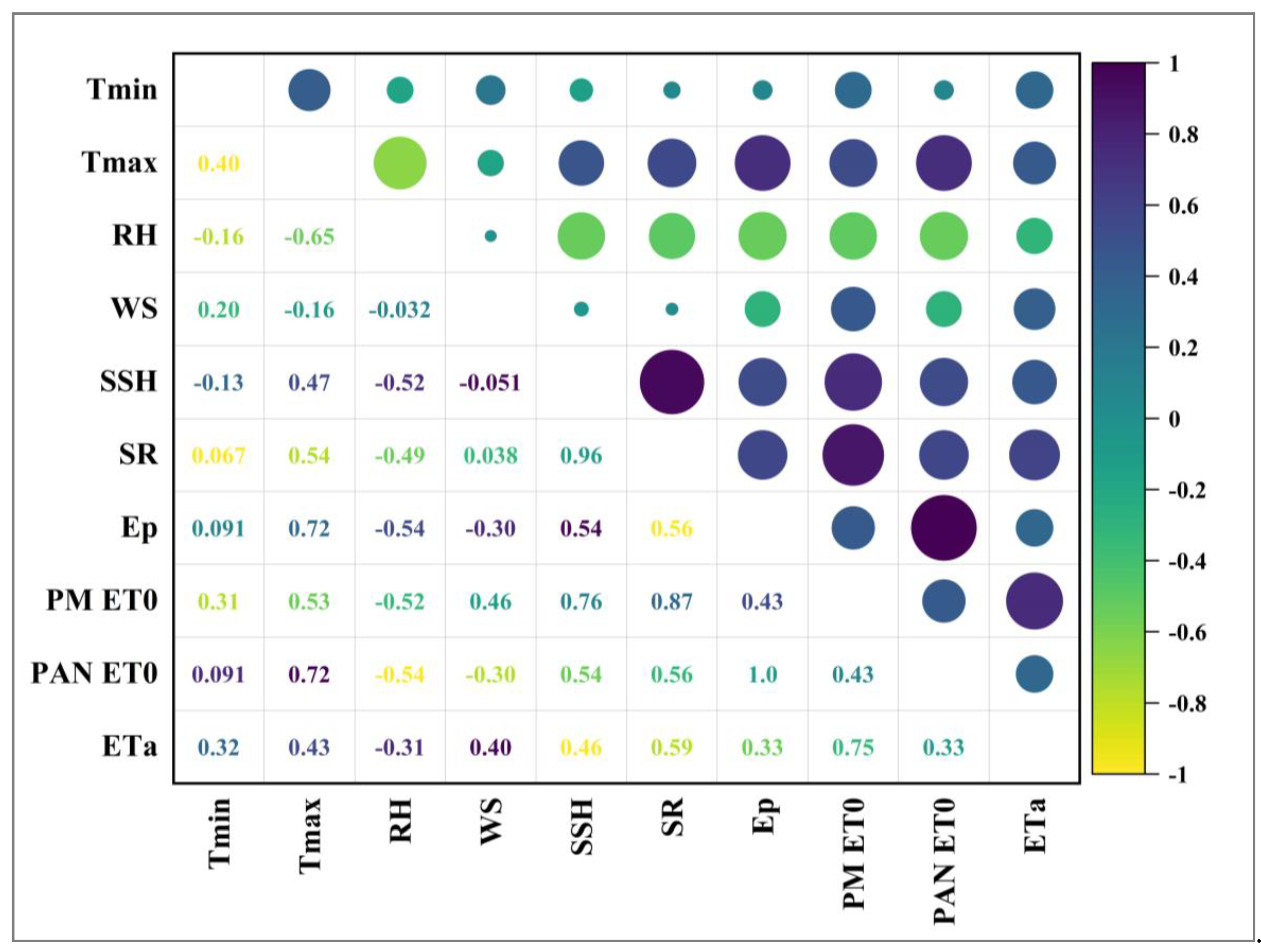
| Weeks | Weather Parameters | ||||||
|---|---|---|---|---|---|---|---|
| Minimum Temp. (°C) | Maximum Temp. (°C) | Relative Humidity (%) | Wind Speed (km/h) | Sunshine Hours | Pan Evaporation (mm) | Weekly Total Rainfall (mm) | |
| 1 | 26.8 | 32.8 | 78.0 | 7.3 | 2.3 | 4.3 | 67.4 |
| 2 | 27.3 | 33.3 | 77.0 | 2.8 | 1.8 | 4.2 | 70.6 |
| 3 | 26.9 | 32.6 | 81.6 | 4.4 | 2.8 | 4.5 | 25.4 |
| 4 | 26.9 | 34.1 | 74.9 | 6.4 | 5.1 | 4.7 | 59.4 |
| 5 | 26.4 | 31.8 | 83.7 | 4.6 | 0.7 | 4.0 | 74.4 |
| 6 | 26.9 | 34.1 | 76.4 | 3.5 | 4.3 | 4.7 | 10.4 |
| 7 | 26.7 | 33.7 | 74.4 | 7.1 | 6.5 | 4.7 | 54.3 |
| 8 | 25.8 | 31.5 | 83.4 | 8.4 | 2.0 | 3.2 | 55.0 |
| 9 | 26.8 | 33.4 | 75.6 | 5.4 | 5.7 | 4.6 | 12.1 |
| 10 | 25.3 | 30.8 | 79.9 | 9.2 | 2.8 | 3.9 | 34.4 |
| 11 | 24.5 | 32.8 | 79.0 | 1.9 | 5.1 | 4.6 | 0.4 |
| 12 | 25.4 | 33.8 | 74.4 | 3.5 | 4.2 | 4.4 | 1.2 |
| 13 | 23.3 | 31.2 | 76.7 | 5.0 | 4.9 | 4.2 | 27.2 |
| 14 | 22.4 | 30.4 | 77.0 | 2.6 | 0.6 | 3.8 | 0.0 |
| Parameters | Values | Methods Employed for Estimation |
|---|---|---|
| Particle size distribution (%) | Hydrometer method [55] | |
| Sand | 54 | |
| Silt | 28 | |
| Clay | 18 | |
| Soil texture | Sandy loam | |
| Hydraulic conductivity (cm/h) | 1.55 | Klute and Dirksen method [56] |
| Bulk density (g/cm3) | 1.52 | Core sampler [57] |
| pH (1:1 soil: water) | 7.87 | Elico pH meter [58] |
| Organic content (%) | 0.51 | Walkley and Black method [59] |
| Field capacity (%) | 18.42 | Pressure plate apparatus [60] |
| Permanent wilting point (%) | 8.42 |
| Crop Growth Stages | ETc-PM (mm Day−1) | ETc-Pan (mm Day−1) | (mm Day−1) |
|---|---|---|---|
| Initial | 3.59 ± 0.77 | 3.15 ± 0.69 | 3.86 ± 0.95 |
| Crop development | 4.05 ± 1.16 | 3.59 ± 0.60 | 4.51 ± 1.41 |
| Mid-season | 4.07 ± 1.26 | 3.61 ± 0.67 | 4.05 ± 1.28 |
| End season | 2.50 ± 0.50 | 2.67 ± 0.26 | 2.52 ± 0.51 |
| Overall | 3.84 ± 1.21 | 3.45 ± 0.69 | 4.02 ± 1.35 |
| Variables | Kc-Actual | Kc-Pan | FAO-Kc |
|---|---|---|---|
| Kc-actual | 0.933 | 0.972 | |
| Kc-Pan | 0.933 | 0.852 | |
| FAO-Kc | 0.972 | 0.852 |
| Agrometeorological Indices | Tillering | Panicle Initiation | Flowering | Physiological Maturity | Harvesting |
|---|---|---|---|---|---|
| GDD | 698 | 1117 | 1748 | 2024 | 2321 |
| HTU | 1881 | 3287 | 5679 | 6975 | 8138 |
| PTU | 9200 | 13,929 | 21063 | 23.94 | 25,995 |
| RTD | 17.9 | 19.10 | 20.8 | 23.7 | 26.3 |
| Agrometeorological Indices | Grain Yield | Dry Biomass |
|---|---|---|
| HUE | 2.40 | 8.50 |
| HTUE | 0.62 | 2.41 |
| PTUE | 0.21 | 0.75 |
Publisher’s Note: MDPI stays neutral with regard to jurisdictional claims in published maps and institutional affiliations. |
© 2022 by the authors. Licensee MDPI, Basel, Switzerland. This article is an open access article distributed under the terms and conditions of the Creative Commons Attribution (CC BY) license (https://creativecommons.org/licenses/by/4.0/).
Share and Cite
Kumari, A.; Upadhyaya, A.; Jeet, P.; Al-Ansari, N.; Rajput, J.; Sundaram, P.K.; Saurabh, K.; Prakash, V.; Singh, A.K.; Raman, R.K.; et al. Estimation of Actual Evapotranspiration and Crop Coefficient of Transplanted Puddled Rice Using a Modified Non-Weighing Paddy Lysimeter. Agronomy 2022, 12, 2850. https://doi.org/10.3390/agronomy12112850
Kumari A, Upadhyaya A, Jeet P, Al-Ansari N, Rajput J, Sundaram PK, Saurabh K, Prakash V, Singh AK, Raman RK, et al. Estimation of Actual Evapotranspiration and Crop Coefficient of Transplanted Puddled Rice Using a Modified Non-Weighing Paddy Lysimeter. Agronomy. 2022; 12(11):2850. https://doi.org/10.3390/agronomy12112850
Chicago/Turabian StyleKumari, Arti, Ashutosh Upadhyaya, Pawan Jeet, Nadhir Al-Ansari, Jitendra Rajput, Prem K. Sundaram, Kirti Saurabh, Ved Prakash, Anil K. Singh, Rohan K. Raman, and et al. 2022. "Estimation of Actual Evapotranspiration and Crop Coefficient of Transplanted Puddled Rice Using a Modified Non-Weighing Paddy Lysimeter" Agronomy 12, no. 11: 2850. https://doi.org/10.3390/agronomy12112850
APA StyleKumari, A., Upadhyaya, A., Jeet, P., Al-Ansari, N., Rajput, J., Sundaram, P. K., Saurabh, K., Prakash, V., Singh, A. K., Raman, R. K., Gaddikeri, V., & Kuriqi, A. (2022). Estimation of Actual Evapotranspiration and Crop Coefficient of Transplanted Puddled Rice Using a Modified Non-Weighing Paddy Lysimeter. Agronomy, 12(11), 2850. https://doi.org/10.3390/agronomy12112850









